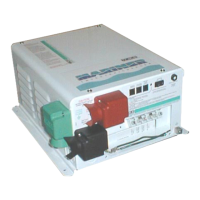7+5((67$*(%$77(5<&+$5*(5
&RS\ULJKW7UDFH(QJLQHHULQJ&R,QF 7HOHSKRQH 3DUW1XPEHU
WK
6WUHHW1( )D[ 2FWREHU
$UOLQJWRQ:$86$ ZZZWUDFHHQJLQHHULQJFRP
3DJH
Table 11, Bulk and Float Setpoints
Typical Bulk & Float Setpoints for Lead-Acid Batteries
Battery Type Bulk Volts Float Volts
Gelled Lead-Acid (sealed) 14.1 volts 13.5 volts
Liquid Lead-Acid (non-sealed) 14.5 volts 13.4 volts
&KDUJHU$&5 HTXLUHPHQWV
The maximum charge rate of the battery charger is dependent upon the peak AC voltage available.
Since the battery charger uses only the top portion of the input sine wave, small variations in peak
voltage results in large variations in the amount of energy to the charger. This charger’s output is
rated on the basis of shorepower input, which typically has a peak voltage of 164 volts (230 volt AC
power has a peak of 330 volts). Peak voltage may be inadequate at older marina’s, on individual
docks, and from other AC sources.
It takes a powerful AC generator to maintain the full 164-volt peak while delivering the current
necessary to operate the charger at its maximum rate (typically 5KW for 2500 VA models and 6 kW
for 3000 VA models). Smaller generators will have the tops of their waveform clipped under such
loads. Running at these reduced peak voltages will not harm the charger, but it will limit the
maximum charge rate. Large auxiliary AC loads may exacerbate this problem.

